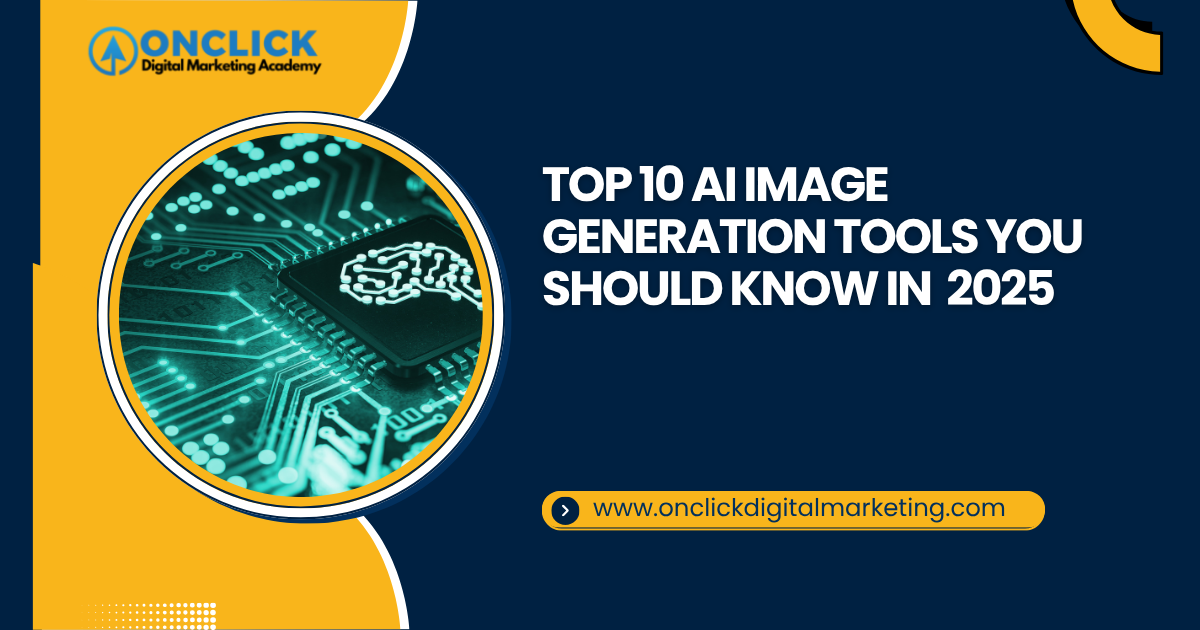- 9985023500 | 9346775340
- onclickhyderabad@gmail.com
- Abids | Ameerpet | Dilsukhnagar | Kukatpally

In the ever-evolving world of design, marketing, and digital content, AI-powered image generation has emerged as a transformative force. What once required days of manual effort and specialized skills can now be accomplished in minutes — all thanks to advanced generative AI models that turn text prompts into high-quality visuals.
From creative agencies to small businesses and freelancers, more professionals are integrating AI art tools into their workflows to enhance productivity, boost creativity, and stay ahead of the competition. But with so many tools available, how do you choose the right one?
Below, we break down 10 of the top AI image generation tools to explore in 2025, what makes each unique, and how you can use them strategically in your projects.
Midjourney has earned a loyal following among designers and visual artists for its signature, dreamlike style. It’s accessible through Discord, where users type prompts and receive AI-generated images within seconds.
Midjourney is particularly good at producing stylized, painterly, or surreal visuals that feel like pieces of conceptual art — making it a favorite for mood boards, social campaigns, album covers, and brand storytelling.
Professional tip: Use detailed style references in your prompts (e.g., “cyberpunk cityscape, cinematic lighting, digital painting”) to get remarkable results.
OpenAI’s DALL·E 3 takes natural language understanding to the next level. With this tool, you can craft images that match your prompts with impressive accuracy — from realistic product shots to whimsical illustrations. Integrated within ChatGPT (for Plus/Pro users) and available via API, DALL·E 3 is user-friendly and delivers high-resolution images ideal for commercial use.
Professional tip: Combine DALL·E with other design tools to fine-tune outputs — it’s great for creating base visuals that can be refined in Photoshop or Illustrator.
Unlike closed platforms, Stable Diffusion is open-source and developer-friendly. Its biggest draw is flexibility — creative professionals can run it locally, train custom models for niche styles, or experiment with community-made models.
Studios often rely on Stable Diffusion for stylized art (like anime or comics) or photorealistic renders for storyboards and prototypes.
Professional tip: Join active communities like Civitai to discover custom models that suit your industry or aesthetic.
Adobe Firefly brings generative AI into the heart of the Creative Cloud ecosystem. Designers love Firefly because it provides commercially safe outputs and integrates seamlessly with Photoshop and Illustrator — making it easy to edit, blend, and adapt AI-generated images for print and digital assets.
Professional tip: Use Firefly’s generative fill or style transfer to quickly create variations on brand visuals while maintaining consistency.
Not every team has a dedicated designer — and that’s where Canva shines. Known for its easy drag-and-drop design, Canva now offers a built-in AI image generator, enabling non-designers to create visuals that match their brand’s look and feel.
This is especially valuable for startups and small businesses that need social posts, ads, presentations, or marketing materials on tight deadlines.
Professional tip: Combine AI images with Canva’s branded templates to stay consistent across campaigns.
Microsoft’s Bing Image Creator is powered by OpenAI’s DALL·E and included in Microsoft Designer — making it freely accessible to anyone with a Microsoft account. It’s simple, quick, and surprisingly capable for everyday design tasks like blog banners, slides, or educational visuals.
Professional tip: Pair Bing’s AI image creation with PowerPoint or Word to level up your presentations and documents.
If you work in gaming, film, or immersive digital experiences, Leonardo.Ai is worth exploring. It offers professional-grade tools for training custom models, fine-tuning outputs, and generating concept art, characters, or environment designs that match specific creative briefs.
Studios, game developers, and 3D artists use Leonardo to prototype faster, freeing up human artists to refine and polish the final work.
Professional tip: Use Leonardo for early-stage visual development — then pass assets to your art team for detailing and animation.
Runway’s Gen-2 model goes beyond static images. It can transform text into video or turn stills into short clips, bringing motion and storytelling into your AI workflow. Marketers and content creators increasingly rely on Runway for social media ads, experimental films, or eye-catching motion graphics.
Professional tip: Use Runway’s text-to-video to create fast, shareable reels for TikTok, Instagram, or YouTube Shorts.
NightCafe makes AI art accessible and fun while offering multiple models to explore different styles — from realistic to abstract. Its credits-based system and supportive community attract both hobbyists and pros experimenting with style variations for prints, merchandise, or NFT art.
Professional tip: Use NightCafe for side projects like print-on-demand art or custom merchandise designs.
Dream by WOMBO is a simple yet powerful mobile app that turns text into vivid digital art within seconds. It’s best suited for quick inspiration, on-the-go brainstorming, or sharing unique art on social channels.
Professional tip: Use Dream to create rough visual ideas when you’re away from your desk, then refine them in other design software.
The best AI image generator depends on your industry, workflow, and goals:
Need complete creative control? Choose Stable Diffusion.
Want polished, editable assets? Try Adobe Firefly.
Looking for stunning, artistic visuals fast? Midjourney and DALL·E 3 are top choices.
Managing daily marketing tasks? Canva and Bing make it simple and cost-effective.
Working in gaming or video? Leonardo and Runway will expand your creative toolkit.
AI image generation is not replacing human creativity — it’s supercharging it. Used thoughtfully, these tools can help you save time, expand your ideas, and elevate the quality of your work.
Whether you’re a designer, marketer, game developer, or content creator, mastering these tools will help you stay competitive and push your creative boundaries.
Experiment boldly. Refine strategically. And remember: the best results come from combining human vision with AI’s speed and versatility.